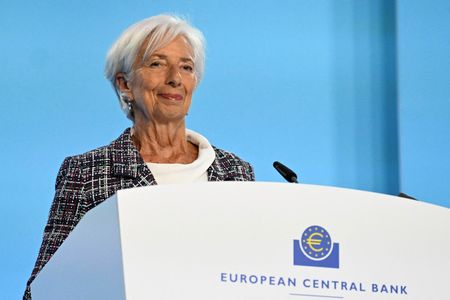By Balazs Koranyi and Francesco Canepa
FRANKFURT (Reuters) -The European Central Bank kept interest rates unchanged as expected on Thursday, with its president Christine Lagarde saying a move in September was “wide open”.
The ECB cut rates from record highs last month in a move that even some of its policymakers considered rushed after progress on lowering inflation to its 2% target stalled. With domestic inflation still stubbornly high and wage growth sticky, the bank is likely to be more cautious about a follow-up step.
But Lagarde also emphasised in her commentary on the decision that risks to growth were “tilted to the downside”, omitting a line from a previous formulation which had judged that risks were balanced, at least in the near-term.
“A weaker world economy or an escalation in trade tensions between major economies would weigh on euro area growth,” she told a press conference, adding it was also possible that high interest rates could hit activity harder than expected.
Investment indicators point to muted growth in 2024, Lagarde continued, noting that the euro zone economy had probably grown at a slower pace in April-June than the first quarter’s 0.3%.
On its next steps, the ECB repeated that it will not pre-commit to any rate path and that data would guide decisions.
“So the question of September and what we do in September is wide open,” said Lagarde, who also chose not to repeat a comment she made after June’s rate cut that there was now a “strong likelihood” the dialling back of monetary policy was underway.
The euro eased fractionally after Thursday’s decision which had been telegraphed by policymakers in recent weeks. The September meeting will come at around the time that markets also see the U.S. Federal Reserve cutting.
“In central banking, there is safety in numbers. With the Fed likely to cut rates in September, the (ECB) Governing Council will do so too,” said Stefan Gerlach, chief economist at EFG Bank in Zurich.
Markets are pricing in almost two ECB rate cuts for the rest of the year and a little more than five moves by the end of next year, a view no policymaker has openly challenged for weeks.
Although investors will seek stronger guidance, the central bank for the 20 countries that share the euro currency has burned itself in the past by being overly specific.
It committed to a June rate cut months in advance, and when a string of last-minute data pointed to elevated wage and price pressures the merit of the step was questioned by economists as well as some ECB policymakers.
Another issue is that the Sept. 12 policy meeting is unusually far away and a rich set of economic data will come out before policymakers meet again.
Quarterly figures on growth, wages and productivity are all due out by September, plus two more monthly inflation readings, while the ECB will give its own new inflation and growth projections at the meeting.
This suggests that policymakers are unlikely to firm up their view on the September meeting until the closing weeks of August at the earliest.
STICKY SERVICES COSTS
The ECB’s key concern is that domestic prices, particularly for services, are moving sideways, while relatively quick wage growth threatens to perpetuate inflation above the ECB’s target.
Multi-year wage deals already struck point to easing wage pressures later this year, suggesting that more benign numbers should come through eventually.
The economy also remains relatively weak, with a string of surveys pointing to anaemic growth, easing fears that buzzing summer activity, particularly in tourism, will further fuel price pressures.
But much of this is still just a hope and there have been few hard indicators coming through since the June 6 rate cut to confirm that projections are materialising into fact.
Some also argue that the ECB is downplaying risks to its central scenario, which puts inflation back at its 2% target by the end of 2025 even as rates continue to ease.
(Editing by Catherine Evans)





